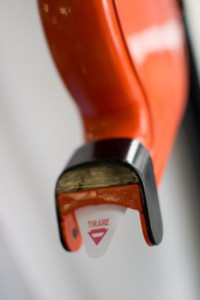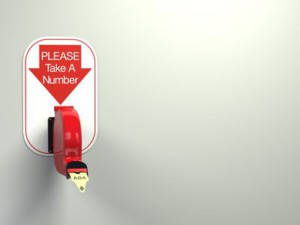 The lead time of a system is heavily influenced by both the utilization and the variation. There are approximations available to estimate this relation, and one of them is the Kingman formula. In this post I would like to introduce you to this equation and describe the fundamental understanding of it. Luckily, you don’t really need the formula for your daily dose of lean. The equation itself has little practical use. However, this relationship is important for understanding the behavior of your production system. While you won’t use the Kingman formula to evaluate your production system, understanding the equation will help you in tweaking your system in the right direction.
The lead time of a system is heavily influenced by both the utilization and the variation. There are approximations available to estimate this relation, and one of them is the Kingman formula. In this post I would like to introduce you to this equation and describe the fundamental understanding of it. Luckily, you don’t really need the formula for your daily dose of lean. The equation itself has little practical use. However, this relationship is important for understanding the behavior of your production system. While you won’t use the Kingman formula to evaluate your production system, understanding the equation will help you in tweaking your system in the right direction.
Ship to Line
 Ship to Line (STL) is yet another technique in lean to optimize your material flow. The idea’s gist is that instead of bringing material to the warehouse, you deliver it directly to the line or to the point of consumption. Like a freshly delivered pizza, you don’t put it on the shelf and eat it two days later. However, for Ship to Line to work, there are a few things to be aware of and to take care of. Let me explain:
Ship to Line (STL) is yet another technique in lean to optimize your material flow. The idea’s gist is that instead of bringing material to the warehouse, you deliver it directly to the line or to the point of consumption. Like a freshly delivered pizza, you don’t put it on the shelf and eat it two days later. However, for Ship to Line to work, there are a few things to be aware of and to take care of. Let me explain:
Just in Sequence Part 3 – What Can Go Wrong
 This third and last post on Just in Sequence details all the things that can go wrong, and talks about how to fix them. The biggest problem is if the sequence of your Just in Sequence part does not match the main component that it should be sequenced to. This happens especially due to defects and rework. I also describe common options to deal with these problems – but be warned: all of them suck. As usual in lean, it is so much easier not to have problems in the first place than it is to deal with them afterward.
This third and last post on Just in Sequence details all the things that can go wrong, and talks about how to fix them. The biggest problem is if the sequence of your Just in Sequence part does not match the main component that it should be sequenced to. This happens especially due to defects and rework. I also describe common options to deal with these problems – but be warned: all of them suck. As usual in lean, it is so much easier not to have problems in the first place than it is to deal with them afterward.
Just in Sequence Part 2 – How to Do It
 In this second post on Just in Sequence, I would like to talk about some details on the actual sequencing of parts: when to use Just in Sequence in the first place, which parts to sequence, and how to define the sequence. These are all organizational details to make Just in Sequence work. In my next and last post of this series, I will describe how to handle problems with parts being out of sequence.
In this second post on Just in Sequence, I would like to talk about some details on the actual sequencing of parts: when to use Just in Sequence in the first place, which parts to sequence, and how to define the sequence. These are all organizational details to make Just in Sequence work. In my next and last post of this series, I will describe how to handle problems with parts being out of sequence.
Just in Sequence Part 1 – What Is It?
 “Just in Sequence” (JIS) is a good way to supply material to high-mix, low-volume production. It combines well with “Just in Time” (JIT) and “Ship to Line” (STL), but neither are a prerequisite for Just in Sequence. In automotive it is sometimes also called In Line Vehicle Sequence (ILVS). In this series of posts I would like to talk about what Just in Sequence is, how it works, and what to be aware of. This first post details the basics of Just in Sequence production.
“Just in Sequence” (JIS) is a good way to supply material to high-mix, low-volume production. It combines well with “Just in Time” (JIT) and “Ship to Line” (STL), but neither are a prerequisite for Just in Sequence. In automotive it is sometimes also called In Line Vehicle Sequence (ILVS). In this series of posts I would like to talk about what Just in Sequence is, how it works, and what to be aware of. This first post details the basics of Just in Sequence production.
Different Ways to Establish a Pull System – Part 2
 This is the second post on different types of pull production. It features the less commonly known approaches of triangle kanban, drum-buffer-rope, reorder point (surprise, yes, it is a pull system), reorder period (also a pull system), and FIFO lanes. In my previous post I showed you the kanban system and its variant, the two-bin system, as well as CONWIP and the kanban-CONWIP hybrid.
This is the second post on different types of pull production. It features the less commonly known approaches of triangle kanban, drum-buffer-rope, reorder point (surprise, yes, it is a pull system), reorder period (also a pull system), and FIFO lanes. In my previous post I showed you the kanban system and its variant, the two-bin system, as well as CONWIP and the kanban-CONWIP hybrid.
Different Ways to Establish a Pull System – Part 1
 Pull production is one of the most important aspects of lean production. Its key feature is to have an upper limit on inventory that is not to be exceeded. The most well-known way to implement a pull system is by using kanban cards. However, there are many others. In this short series of two posts, I want to give you an overview of the different ways to implement pull systems, and discuss the pros and cons of them.
Pull production is one of the most important aspects of lean production. Its key feature is to have an upper limit on inventory that is not to be exceeded. The most well-known way to implement a pull system is by using kanban cards. However, there are many others. In this short series of two posts, I want to give you an overview of the different ways to implement pull systems, and discuss the pros and cons of them.

